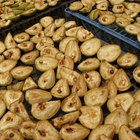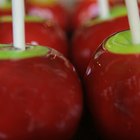bhofack2/iStock/GettyImages
Drying fruits was once one of the few ways to store them for long-term use during the long months until the next year's harvest. In the modern world fruit such as apples can be kept in climate-controlled warehouses from one year to the next, but dried fruits are still a favorite for their chewy texture and richly concentrated flavors. If you have a home dehydrator, it only takes a day or so to produce your own dried apples.
Factors Affecting Drying
A number of factors can affect your drying time. Some apple varieties are denser than others and dry more slowly. The same is true of apples with a high moisture content. Apples cut to a quarter-inch thickness dry more slowly than eighth-inch slices, while thinly shaved apple "chips" dry very rapidly. A high-quality dehydrator maintains a steady 140 degrees Fahrenheit and uses a powerful fan to circulate the air effectively. Light-duty models with smaller fans and poorer temperature control can take almost twice as long to dry your apples.
Drying Time Estimates
If you're using a high-quality dehydrator capable of maintaining a steady 140 degrees F, apple chips or very thin slices might be ready in as little as five hours. Apples sliced to one-eighth inch can take six to 10 hours, while quarter-inch slices can take up to 24 hours in a high-quality dehydrator or double that in a light-duty model. They're done when they are dry and leathery to the touch and flex but don't break. Thin apple chips are the exception, and are usually dried until crisp.
Preparing Your Apples
Choose only perfect apples for drying, with no visible bruising, soft spots or insect damage. They should be rinsed carefully in cold water and dried on clean paper towels. You can peel them or not, as you like. Core the apples and slice them into thin, even pieces. Hardware and department stores commonly sell a cutting-coring-peeling tool that can do most of the work for you in a single step, producing perfect eighth-inch rings. Dip the cut apples in a solution of ascorbic acid, citric acid or lemon juice, if you wish, to inhibit browning and microbial growth.
Drying and Storing
Arrange your apples in even layers on the drying trays, leaving lots of room for the air to circulate. Place them in the prewarmed dehydrator and leave them for several hours. Your dehydrator's manufacturer may recommend rotating the trays periodically or turning the slices to promote even drying, so check your instructions. Once the apple slices are dried, transfer them to a wire rack to cool completely. Pack the cooled slices into a jar with a loose-fitting lid and let them rest for six to 10 days so their moisture content can even out. Shake the container occasionally during this time to redistribute the slices. After they've cured in the jar, pack the slices into airtight packaging and store them in your cupboard or freezer.
Related Articles

How to Dehydrate Pears

How to Dry Pineapple in a Dehydrator

How to Smoke Fruit to Preserve It

How to Dry Sliced Oranges in the Oven

How to Dry Jujube Fruit

How to Dehydrate Kiwi

How to Freeze Apples With Lemon Juice

How to Turn Plums Into Prunes

How to Dehydrate Turnips

How to Dry Mulberries

How to Dry Radishes

How to Dry Limes

How to Dry Wild Morel Mushrooms
How Long Can You Freeze Fresh ...

How to Ship Candy Apples

How to Dry or Preserve Blueberries

How to Dry Blueberries in a Dehydrator

How to Know When Nail Polish Is Dry

How to Dry Tomatoes in the Oven

How to Dehydrate Vegetable Chips
References
Writer Bio
Fred Decker is a trained chef and prolific freelance writer. In previous careers, he sold insurance and mutual funds, and was a longtime retailer. He was educated at Memorial University of Newfoundland and the Northern Alberta Institute of Technology. His articles have appeared on numerous home and garden sites including GoneOutdoors, TheNest and eHow.